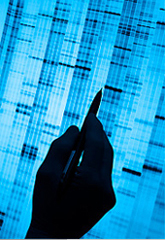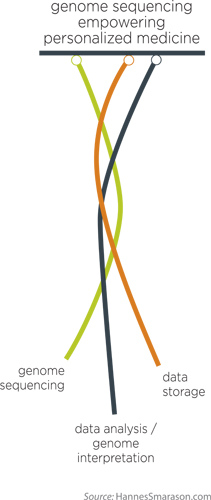
Leaders in the medical community are actively enhancing their facilities with DNA sequencers and supercomputers—steps toward the routine sequencing of patient genomes that will inform the full spectrum of care decisions.
It is increasingly evident that sequencing and analyzing genomic information can contribute to more informed healthcare decisions, and major research institutions and medical centers around the world seem to agree.
Leaders in the medical community are actively enhancing their facilities with DNA sequencers and supercomputers, recognizing the efficiencies of having this advanced technology at their disposal for innovative research programs. And as they look to the future, they are taking steps toward the routine sequencing of patient genomes that will inform the full spectrum of care decisions, from defining risk, to diagnosing disease, to defining the ideal course of treatment for the best possible outcome.
Just a few examples of the major advances in the use of sequencing technologies that have been announced recently…
From medical centers:
- Mount Sinai Medical Center in New York initiated a program in which 24,000 patients participate in a biobank to include their DNA sequence and research over their lifetimes. The program, called BioMe™, is among the largest in the United States.
- Memorial Sloan-Kettering Cancer Center researchers are active in a range of collaborations that seek to understand the molecular changes that characterize cancer, the largest of which is The Cancer Genome Atlas (TCGA), a project jointly funded by the NCI and the National Human Genome Research Institute. MSK currently houses one of TCGA’s Genome Data Analysis Centers.
- Phoenix Children’s Hospital launched a new molecular and personalized medicine research institute that will “bring genomics research to the forefront of pediatrics.” The infrastructure will include a range of capabilities, such as a biospecimen repository, DNA sequencing and analysis, and a CLIA lab for genomic profiling.
And research institutions:
- The Wellcome Trust Sanger Institute is dramatically upgrading its storage and data management capacity. The Institute already operates 30 DNA sequencers, each of which generates roughly a terabyte of data every day. New upgrades will double their capacity and improve data management and organization software.
- Harvard Medical School’s Center for Biomedical Informatics, conducts informatics research with a strong emphasis on translational science informed by innovative computational strategies; the research staff use mathematical modeling to predict when genetic information could lead to more effective treatment.
By members of industry:
- Google is jumping into the genomics industry with the launch of “Calico,” a new company that will focus on genomic sequencing and advanced analytics to identify solutions for some of the most challenging diseases today.
- “N-of-One” is a company offering personalized cancer treatment strategies as a new employee benefit tool for innovative, health-minded employers. Through the service, the company provides interpretation of molecular profiling to employees, their family members fighting cancer and their physicians to help inform treatment decisions.
And even the U.S. government:
- The National Institutes of Health is one of the greatest proponents of genomic sequencing for research purposes. In fact, a recently initiated program is funding research teams to examine whether sequencing newborn genomes or exomes may provide useful information beyond what is currently captured in newborn screening programs.
- Further, in the fight against infectious diseases and “super-bugs,” the National Institute of Allergy and Infectious Diseases established the Genomic Sequencing Centers for Infectious Diseases (GSCID) to sequencing priority pathogens, microorganisms responsible for emerging and re-emerging infectious diseases and related organisms.
With such a broad array of innovative research underway within the halls of the world’s leading institutions, there is no doubt sequencing is on the verge of delivering exciting breakthroughs in medicine. In fact, we’re seeing evidence of this with NextCODE, which has engaged with several “early adopter” organizations around the globe. Check it out here.


